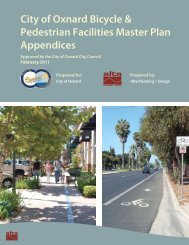Santa Clara River Trail Final Master Plan - Development Services ...
Santa Clara River Trail Final Master Plan - Development Services ...
Santa Clara River Trail Final Master Plan - Development Services ...
You also want an ePaper? Increase the reach of your titles
YUMPU automatically turns print PDFs into web optimized ePapers that Google loves.
Chapter 6: Design Guidelines, Maintenance Schedules and Best Practices<br />
surface treatments should take into consideration that some patterns and joints may cause vibrations<br />
that are uncomfortable for wheelchair users. It is also desirable that the surface be stable, firm and slip<br />
resistant.<br />
In arriving at a recommended trail surface, several key criteria should be considered, including:<br />
<br />
Initial Capital Cost – <strong>Trail</strong> surface costs vary dramatically and dollars to build trails are scarce.<br />
Construction costs include excavation, subbase preparation, aggregate base placement, and<br />
application of the selected trail surface.<br />
<br />
<br />
<br />
<br />
<br />
<br />
Maintenance and Long Term Durability – The anticipated life of a trail surface can vary from a<br />
single year (bark surface in a moist climate) to 25+ years (concrete). In addition, each trail<br />
surface has varying maintenance needs that will require regular to sporadic inspections and<br />
follow-up depending on the material selected. Some surface repairs can be made with volunteer<br />
effort such as on a bark surface trail, while other such as a concrete surface will require skilled<br />
craftsmen to perform the repair.<br />
Life Cycle Cost – An economic life cycle cost analysis evaluates the costs over time for the<br />
surface alternatives. Asphalt pavement was shown to have the lowest life cycle cost over<br />
concrete, permeable concrete and permeable asphalt.<br />
Existing Soil and Environmental Conditions – Soil conditions are predetermined and play a<br />
critical role in surfacing selection. In addition, when considering the use of a permeable concrete<br />
or asphalt surface, the success rate of these surfaces is directly correlated to the permeability of<br />
the soil and climatic conditions. The lower the permeability and moisture, the greater risk of<br />
failure.<br />
Anticipated Use/Functionality – Who are the anticipated users of the trail? Will the trail<br />
surface need to accommodate equestrians, wheelchairs, maintenance vehicles, bicycles, etc.? Does<br />
the trail provide critical access to a popular destination for many users or is it a local access route<br />
to a community park? Multiple use trails attempt to meet the needs of all anticipated trail users.<br />
This may not be feasible with a single trail surface. Considering the shoulder area as a usable<br />
surface, it is possible to provide enough width to accommodate use by those preferring a softer<br />
material. Each surface also has varying degrees of roughness and therefore accommodates varying<br />
users. In-line skates, for example, cannot be used on a chip seal surface or most permeable<br />
concrete surfaces due to the coarseness of the finished surface.<br />
Funding Source – The funding source for the trail may dictate the trail surface characteristics. If<br />
the trail has federal funds and is being administered through Caltrans, funding agency will need<br />
to review and approve the selected trail surface.<br />
Aesthetics – Each trail surface has varying aesthetic characteristics that should fit with the<br />
overall design concept desired for the project and for the neighborhood in which the trail is<br />
located.<br />
Table 9 provides an analysis of path surfacing options. The ranking of each surface option is as follows:<br />
76 | Alta <strong>Plan</strong>ning + Design
















